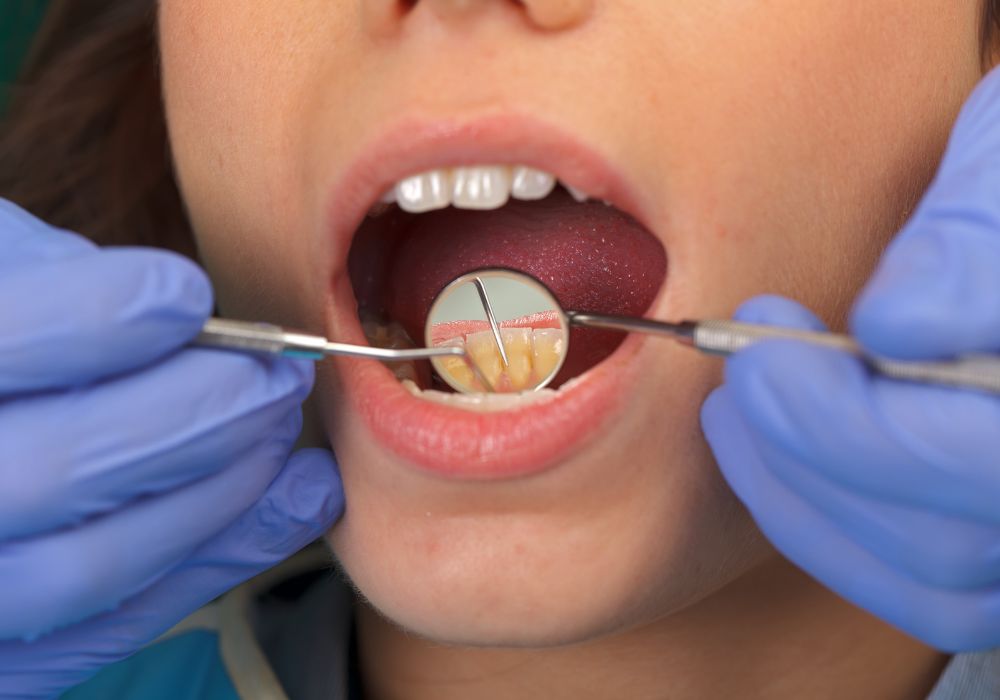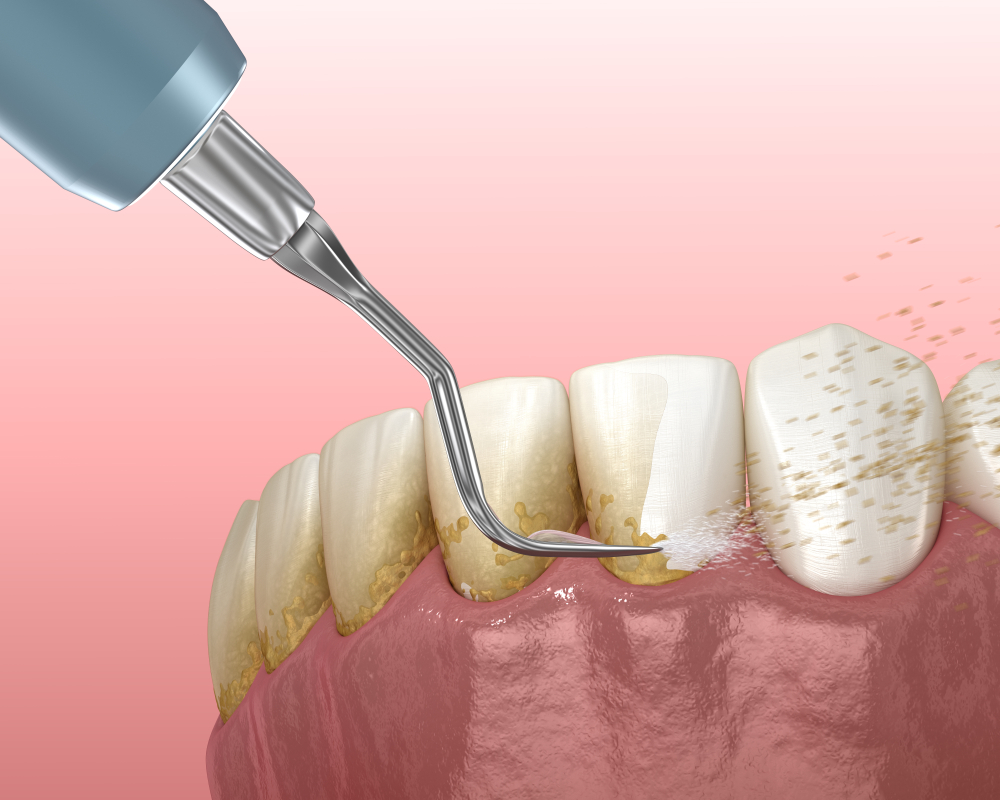Tartar (dental calculus) refers to plaque and minerals from your own saliva that buildup and harden on your teeth. This happens on both the front and the back, and the buildup stains much easier than your normal tooth surface.
This happens even with positive dental hygiene habits. While you can remove tartar with a dental pick or utilize at-home treatments, you still need regular in-office cleaning to eradicate the buildup and make sure it doesn’t travel below your gum line.
This guide explains how best to handle tartar at home, from routine care to DIY treatment methods, as well as why these cannot replace professional cleaning.
Recognizing Tartar Buildup
The first sign of tartar buildup is a rough feel on the tooth surface. At the gum line you may notice yellow, tan, or even brown discoloration. This will grow the longer it’s left alone, even extending below the gum line to contribute to periodontal diseases and other issues.
Tartar buildup contributes to other issues like:
- Chronic bad breath
- Cavities
- Sensitivity
- Gingivitis
- Bleeding/irritated gums
Any combination of these issues is a sign that your teeth aren’t getting as clean as they need to be. Make sure you’re keeping up with proper brushing and flossing habits, try some of the remedies below, and schedule an appointment with your dentist for thorough plaque removal.
How to Handle Tartar at Home: Solid Prevention
It’s easier to prevent plaque buildup than it is to try and scrape or scrub it off. This means you should be:
- Brushing teeth twice daily (ideally in the morning and before bed)
- Using a fluoride toothpaste to strengthen teeth and remineralize enamel
- Flossing at least once daily (ideally twice)
Using an electric toothbrush can increase your cleaning power and be more effective in loosening and removing tartar.
If tartar is a major problem for you, consider switching to a tartar removal toothpaste. On top of fluoride, these toothpastes use ingredients like pyrophosphates, zinc citrate, and triclosan to deal with bacteria that cause plaque.
Removing Tartar with a Dental Pick or a Plaque Scraper
There are two tools you can use to try to remove tartar, although it’s not recommended and still doesn’t replace a session with your dental hygienist.
If you’re in the early stages of development, a dental pick may be enough to remove the tartar building up on your teeth. Use a magnified mirror with good lighting to detect areas of tartar build-up to target.
Gently scrape the texture, moving away from your gumline. Periodically spit into the sink or trash, then rinse your mouth with warm water when you’re done. When using a soft dental pick, you can do this twice daily (usually around the time you floss).
Plaque scrapers (also marketed as “dental scrapers” or “dental scalers”) are also readily available, although they’re much sharper and can more easily irritate or damage your mouth. If you want to use one at home, we recommend having your dentist show you how to make sure you don’t complicate your situation.
Be careful not to cause scratches in the enamel or on your gums. It’s also extremely important to guide the tartar away from the gumline; doing the opposite can actually push it underneath and increase your chances of gum disease, tooth decay, and other oral health issues.
Mild At-Home Treatments

There are plenty of DIY treatments you can use to minimize tartar buildup. While efficacy varies, you can incorporate them in your routine to promote better oral health.
These include:
- Sanguinaria extract
- Hydrogen peroxide
- Oil pulling (coconut oil or sesame oil)
- Baking soda
- Guava fruit
- White vinegar
- Eating spicy foods or those rich in vitamin C
- Aloe Vera
What you ultimately decide on may depend on your taste buds or what you have in your pantry. Keep in mind that none of these methods of management are enough to negate regular teeth cleaning sessions.
Sanguinaria (Bloodroot) Extract
- 3 to 4 drops sanguinaria extract + 1 cup warm water
Bloodroot is a common microbial agent utilized in toothpaste and other dental hygiene products. It is known to reduce plaque levels, slow plaque growth, and reduce gingivitis. To use it to deal with tartar, simply mix a few drops with warm water and swish it around your mouth.
Alternatively, you could incorporate products that contain bloodroot (like those by Viadent) in your daily routines.
Hydrogen Peroxide
- 3 tablespoons hydrogen peroxide + 1 cup water
Hydrogen peroxide is used for a lot of dental issues because of its antimicrobial capabilities. Gargling the mixture for a minute or two will help eradicate bacteria that contributes to tartar buildup.
Oil Pulling
Oil pulling is a traditional practice that has recently resurfaced and gained major traction. Studies show that it’s useful in managing oral health, but only if performed correctly.
To do this you use a full tablespoon of oil (usually cold pressed sunflower oil, sesame oil, or coconut oil) and swish it around your mouth, before eating and brushing, for about twenty minutes.
At the end of the process you simply spit the oil (in the trash, not your drain) and rinse your mouth with warm water. You can do this daily, or at least 2 to 3 times per week.
Baking Soda
You can create a mild abrasive paste with baking soda and water to brush on your teeth using a soft-bristled toothbrush once a week. This will not only scrub off some of the tartar but sooth your gums and potentially whiten teeth.
Like other abrasive methods, it’s important to limit the use of baking soda in your oral hygiene routines.
Guava Fruit
Guava is known to deal with tartar and plaque naturally as well as reduce issues like gum irritation and swelling.
You can either incorporate the fruit into your diet or take a more active approach. Chew guava leaves for a few minutes before spitting them out, or occasionally snack on a salt-covered unripe guava to further break up the buildup.
White Vinegar
- ½ teaspoon of salt + 2 teaspoons white vinegar
The acidity of vinegar is effective in fighting off bacteria that contributes to tartar buildup and other issues. Gargle this mixture once a week or so to remove tartar and plaque that persists after regular brushing and flossing.
Keep in mind that this can demineralize tooth enamel, so you should use it sparingly.
Spicy Foods
Spicy foods promote saliva production, keeping your mouth moist and clearing away harmful bacteria from gums and teeth.
If spicy foods aren’t your thing, consider chewing gum for similar effects. Opt for sugar-free gums for the highest benefits.
Vitamin C Rich Foods
Foods rich in vitamin C have antimicrobial properties to combat bacteria, tartar, and plaque buildup. These include favorites like:
- Tomatoes
- Strawberries
- Oranges’
Like spicy foods, incorporating these in your normal diet does wonders for your teeth.
You can occasionally create a paste using these foods, applying it to your teeth and allowing it to sit for a few minutes to address tartar concerns. Another idea involves rubbing the inside of orange peels on your teeth.
Aloe Vera
- 1 tablespoon aloe vera gel + ½ cup water + pinch of baking soda
Aloe vera is proven to have antimicrobial characteristics that combat free radicals produced by the bacteria that causes plaque and tartar buildup. When combined with an abrasive material like baking soda and left to sit for about 10 minutes, you can combat tartar and other gum issues simultaneously.
Why You Need Regular Cleaning to Remove Tartar
Tartar is undesirable for a number of reasons.
To start, it can be devastating to your self esteem. It stains easily, and can even turn a dark brown depending on your diet and how long it’s been building up. Tartar also harbors bacteria that causes chronic bad breath.
The Department of Health and Human Services points out that, when left alone, gum disease caused by tartar buildup can double or even triple your risk for issues like diabetes, stroke, and heart disease.
A dentist will be able to accurately assess your mouth condition and effectively clean tartar from areas like your gum line and between your teeth. They have access to tools more effective than a plaque scraper and carry the experience to use them without causing further damage.
They will also check for early signs of gum disease to minimize the ultimate effects of these issues. These services are usually included in your regular checkups.
Conclusion
While there are plenty of at-remedies for removing tartar, the best routine involves basic brushing habits and regular professional cleaning. Things like removing tartar with a dental pick, oil pulling, or creating special pastes or scrubs are supplemental at best, and they can even exacerbate the issue if performed incorrectly.
If you’re trying to remove tartar at home, remember to:
- Push it away from the gumline
- Focus on proper teeth brushing and flossing first
- Use gentle touches and methods to prevent further damage
Let us know if you have any other questions regarding tartar buildup, at home treatments, or the importance of professional plaque removal.

